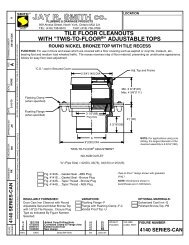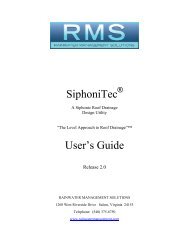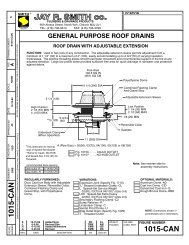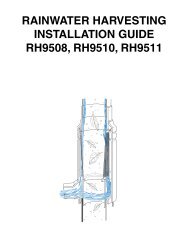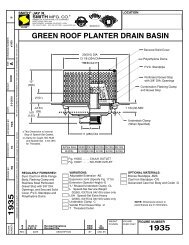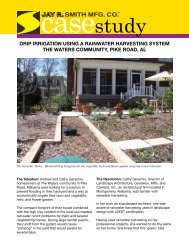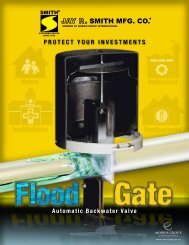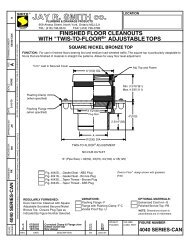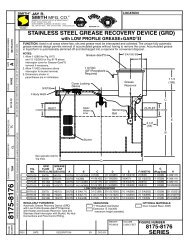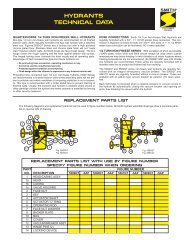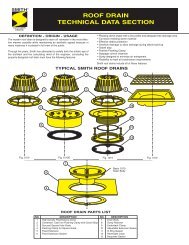Brochure Siphonic Roof Drains - Jay R. Smith MFG Co.
Brochure Siphonic Roof Drains - Jay R. Smith MFG Co.
Brochure Siphonic Roof Drains - Jay R. Smith MFG Co.
You also want an ePaper? Increase the reach of your titles
YUMPU automatically turns print PDFs into web optimized ePapers that Google loves.
<strong>Siphonic</strong> <strong>Roof</strong> <strong>Drains</strong> from <strong>Jay</strong> R. <strong>Smith</strong> Mfg. <strong>Co</strong>. ®<br />
Introduction<br />
After several years of prototype development and testing, <strong>Jay</strong> R.<br />
<strong>Smith</strong> Mfg. <strong>Co</strong>. ® is pleased to provide owners and the plumbing engineering<br />
community patent-pending, specified roof drain products<br />
for siphonic roof drainage systems.<br />
• <strong>Jay</strong> R. <strong>Smith</strong> Mfg. <strong>Co</strong>.’s siphonic roof drains promote<br />
full-bore flow within engineered siphonic roof drainage<br />
piping systems.<br />
• Fully tested and certified in accordance with ANSI/<br />
ASTM A112.6.9 “<strong>Siphonic</strong> <strong>Roof</strong> <strong>Drains</strong>” and representing<br />
the first-line of specified roof drains complying<br />
with this American National Standard.<br />
• Cast of solid ASTM 48 grey iron and utilizing the same<br />
set of accessories already familiar to the plumbing<br />
engineer and installer, thus making specification and<br />
installation as easy as traditional roof drains.<br />
• The castings contain mainly recycled metal content<br />
making the products a part of a sustainable consumer cycle.<br />
• The low-profile nature of the baffle component of competitive<br />
siphonic roof drains can make them prone to quicker<br />
blockage by debris. <strong>Smith</strong>’s siphonic roof drains have a<br />
<strong>Siphonic</strong> <strong>Roof</strong> Drain Anatomy<br />
Air Baffle<br />
polyethylene dome strainer to help protect the baffle from debris<br />
accumulation and allow for the passage of water even if debris<br />
collects around the strainer base. This design makes our siphonic<br />
roof drains behave in the same manner as traditional roof drains in<br />
all types of rainfall and roof conditions.<br />
Overview<br />
In a siphonic roof drainage system, <strong>Smith</strong>’s specially engineered and<br />
tested roof drain baffle allows and sustains negative atmospheric<br />
pressure in the connected piping and inhibits the admission of air<br />
into the piping system hence sustaining full-bore flow and higher<br />
flow volumes and velocities. The hydraulic balance in a siphonic<br />
roof drainage system is achieved by an engineer employing hydraulic<br />
calculations to ensure that the piping system fills up automatically<br />
in cases of moderate to heavy precipitation. The resulting full-bore<br />
or siphonic action allows for the installation of horizontal, i.e., level,<br />
drainage manifold piping serving multiple roof drains. <strong>Siphonic</strong> roof<br />
drainage systems are powered by and discharge to grade by means<br />
of a vertical stack into the point of discharge through the influence of<br />
gravity making them true gravity systems.<br />
Dome Strainer<br />
Drain<br />
Body<br />
Flashing Ring<br />
Outlet<br />
<strong>Co</strong>mponents of a <strong>Siphonic</strong> <strong>Roof</strong> Drain<br />
A siphonic roof drain looks much like a traditional roof drain. The<br />
distinguishing feature of a siphonic roof drain is the air baffle. This<br />
air baffle is engineered and tested to prevent air from entering the<br />
piping system at peak flows.<br />
Other than the baffle, a siphonic roof drain has the same features<br />
as a traditional roof drain including a drain body, flashing ring, dome<br />
strainer, and fastening hardware.<br />
In contrast to traditional roof drains, siphonic roof drains are not<br />
designed with a large diameter or deep sump bowl because their<br />
operation is by means of sub-atmospheric pressure generated at the<br />
under side of the baffle and outlet. The depth of water maintained on<br />
the roof is dependent only on the resistance value of the drain<br />
assembly while operating under siphonic conditions. Any viscous<br />
weir effect of the drain body becomes minor and the flow is determined<br />
by simple inertial hydraulic effect of flow from a high pressure<br />
(atmospheric pressure at the roof surface) to low pressure (within<br />
the piping system).<br />
Unlike a traditional roof drain system, a siphonic system is designed<br />
to operate with the piping completely filled with water during a<br />
rainstorm. Several drains tie into a horizontal collector that is routed<br />
to a convenient point where it transitions into a vertical stack. This<br />
stack, once it reaches the ground, is piped to a vented manhole or<br />
inspection-chamber where the water is discharged at atmospheric<br />
pressure and low velocity into the storm system.<br />
1<br />
<strong>Jay</strong> R. <strong>Smith</strong> Mfg. <strong>Co</strong>. <strong>Co</strong>pyright © 2009 All Rights Reserved



